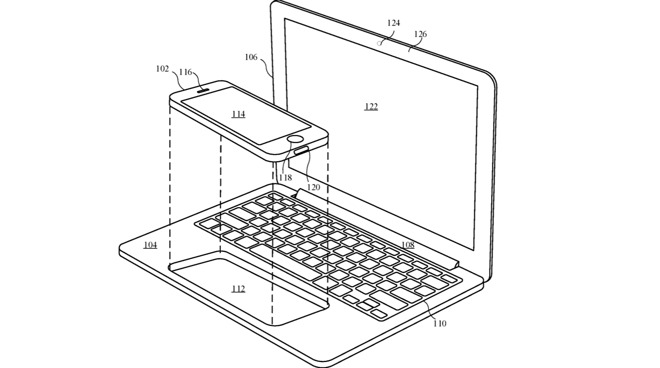A newly published patent reveals that Apple has explored iPhones and iPads that could be docked inside larger devices similar to a MacBook Pro in order to provide extra functionality when needed.

Detail from patent covering the docking of devices such as an iPhone to a casing similar to a MacBook Pro
A future iOS device may be able to physically become part of a larger computer such as a MacBook Pro in order to provide extra features and capabilities, according to the filing; a concept somewhat similar to the PowerBook Duo of decades past, which could slot into a unit to create a desktop Mac.
"The appearance of a portable computing device, including its design and its heft, is important to a user, as the outward appearance contributes to the overall impression that the user has of the portable computing device," writes Apple in "Electronic Accessory Device", US Patent No 10,545,542. "However, due to restrictive amount of available space, the portable computing device can require additional resources to provide extended functionality."
One drawing included with the patent show a seemingly MacBook Pro-like device where the trackpad has been replaced with a slot for an iPhone to go into. Another shows the same larger device but this time with an iPad slotting in where the display usually is.
The device has the form factor of a MacBook Pro but Apple's patent describes it as merely being an "accessory device" to the iPhone or another small "host device."
"[An] accessory device can have limited or no data processing resources," it says. "The accessory device can have a form factor corresponding to a laptop computer and as such can include data output resources such as a visual display and input resources such as a keyboard."
"The accessory device can also include memory resources," it continues. "The accessory device can include a port having a connection mechanism arranged to facilitate a communication channel between the accessory device and a host device. In this way, the host device utilizes resources provided by the accessory device."
One such connection mechanism can be a dock where the host device can utilize all the features of the accessory. As with the old PowerBook Duo dock, Apple describes such electronic accessory as not being usable by itself.
Detail from the patent. It looks at first like a regular laptop, but that's an iPad docked where the screen usually is.
"[The] electronic accessory device can be considered a 'thin' device, in that it extends the functionality of another device but is inoperable by itself as a stand-alone device. As such, the accessory device can have little or no independent processing resources in the form of a CPU or similar comprehensive processor," says Apple.
"The accessory device, however, can provide auxiliary processing resources, such a graphical processing unit, or GPU, or other processing resources that can support the functions of the portable computing device," it continues.
While most of the descriptions and all of the drawings show iPhones and iPads, Apple sees this docking facility as something many devices can used.
"[It] is anticipated that the accessory device is not a stand-alone computing device but only acts in concert with a host device. The host device can be a portable computing device, such as, for example, a smart phone, media player, tablet computer, or other portable computing device," it concludes.
The sole credited inventor on the patent, Brett W. Degner, has more than 100 other patents, most recently including one to do with Apple's potential curved-glass iMac redesign.


